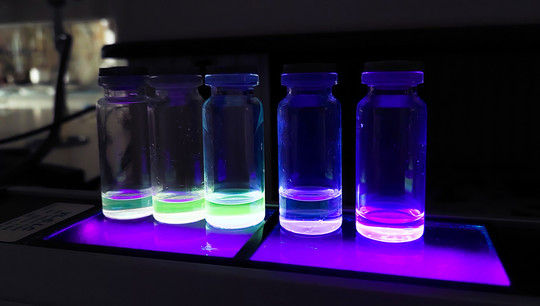Ural Federal University States Where Fluorophores Are Used
Fluorophores (substances that glow under the influence of radiation) are now used in a variety of fields – from bleaching shirts to burning tumors. Fluorophores (substances that glow when exposed to radiation) are used today in a wide range of applications, from household and medical to electronics and security.
“There are different ways to excite luminescence – triboluminescence, chemoluminescence, electroluminescence and others. These methods depend on what the molecules are affected by and how the radiation energy is released. For example, fungi, plankton, and insects all have fluorescence. So, in fireflies, the glow occurs as a result of a chemical reaction,” explains Igor Kovalev, a leading researcher at the Laboratory of Advanced Materials, Green Methods and Biotechnologies at UrFU.
A vivid example of using fluorescence in everyday life is giving clothes a white color. For this purpose, optical brighteners are added to the powder. These are synthetic dyes that settle on the fabric and in sunlight fluoresce in light blue color, so that the yellowish tint is masked, and the thing seems whiter than it really is.
Another example of the use of fluorophores is the coloring of rivers. In this way, it is possible to identify underwater currents, riverbeds or to color them green, as is done on St. Patrick’s Day.
“Fluorophores also help to identify harmful substances in water – mercury, cadmium, zinc. These technologies exist. Detection requires a small portable ultraviolet lamp (currency detector), a paper strip sensor and a dark room where this can be processed. Fluorophores are also effective in express analysis of soil, groundwater and waste water for domestic purposes, when it is necessary to check them for the presence of herbicides, man-made waste or, for example, traces of medicines,” adds Igor Kovalyov.
Medicine is another area of application of fluorophores. With their help it is possible to trace how a drug is assimilated by certain organs of the human body, what changes in human organs and tissues occur, how benign they are.
“They select a certain kind of organic molecule that shines, and attach to it a fragment that is attractive to the cancer cell. The patient receives such a substance, and it accumulates in the cancerous tumor. During surgery, firstly, it is possible to illuminate the clear boundaries of the tumor with ultraviolet light, and, secondly, to burn only cancer cells without damaging healthy cells nearby. This is due to the fact that there is a fluorophore fragment on the molecule of the active ingredient, allowing the generation of reactive oxygen species, which kills this cell. This technology is mainly used to treat skin diseases, as laser radiation can not penetrate deeply, “- says Igor Kovalyov.
“Behavior” fluorophores also serves as an indicator of the presence of explosives. In this case, the receptors of brightly glowing fluorophores form non-luminous complexes with the molecules of explosives in the air in the form of vapor or in solution. In much the same way that a dog detects explosives with the olfactory receptors of its nose. When in contact with explosives fluorophore, as a rule, goes out, as there is a quenching of fluorescence, and this is recorded by a special device.
It should be noted that the scientific team of chemists from the Ural Federal University and the Institute of Organic Synthesis of the Ural Branch of the Russian Academy of Sciences has been working for many years on the creation of environmentally friendly (using the method of “green chemistry”, waste-free and low-waste technologies), inexpensive and simple fluorophores for medical purposes and safety issues.

